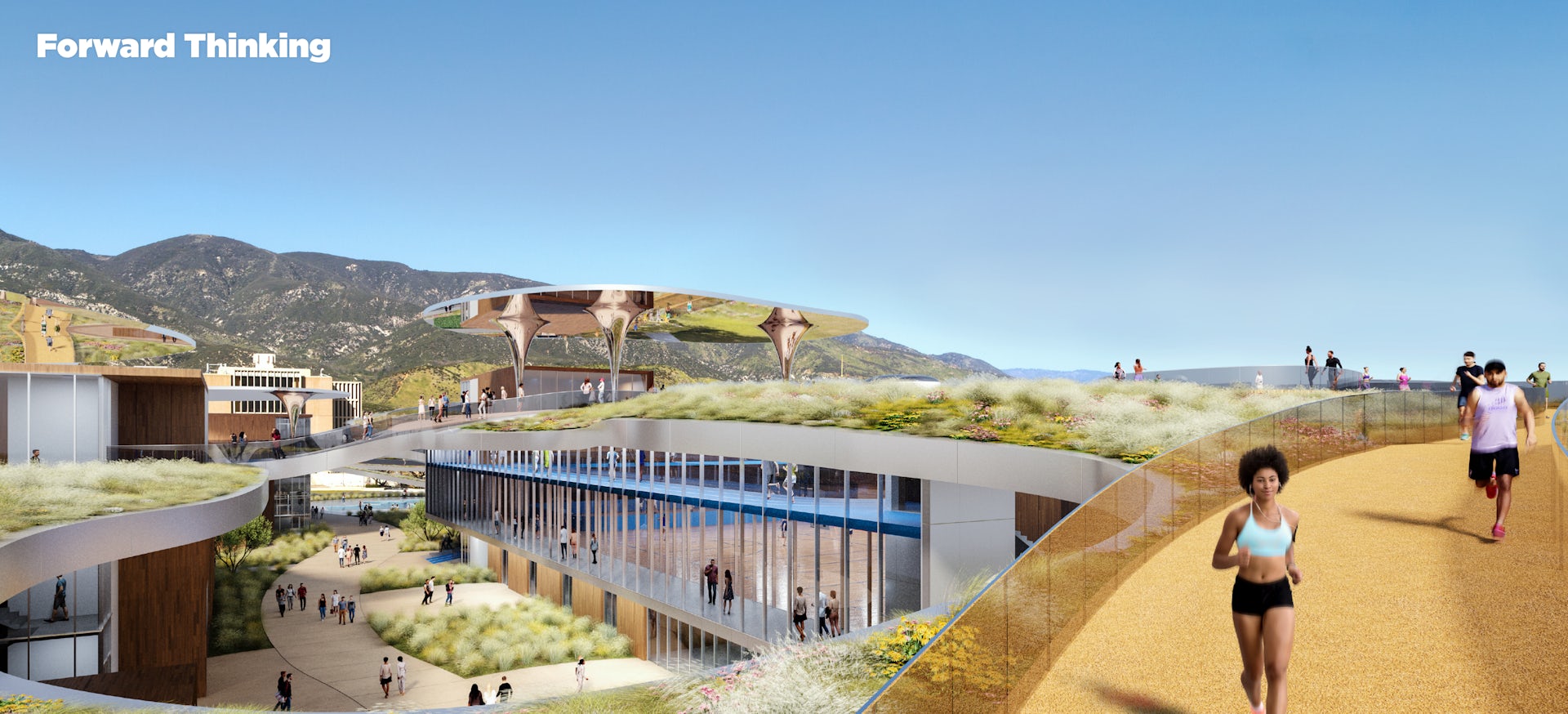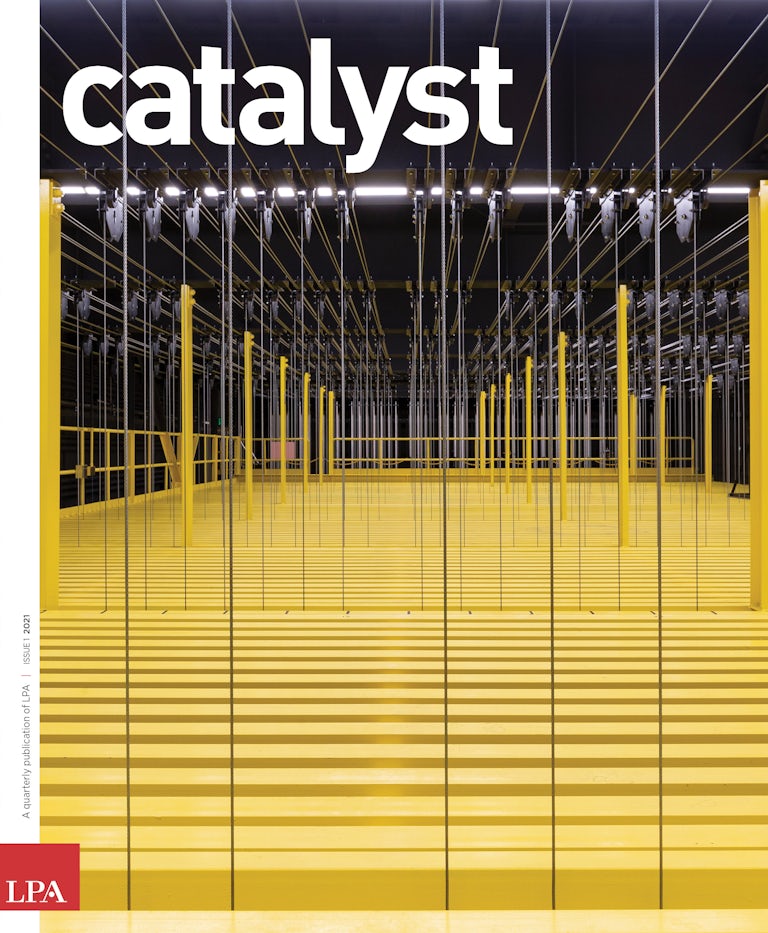For the last few years, LPA’s healthcare and sport + recreation practices have been exploring the different ways facilities can be combined to increase efficiency, better deliver services and address the pressing need to improve the holistic, long-term preventative care model for students. The pandemic raised awareness of the many overlapping challenges facing healthcare and recreation leaders, as they look for ways to cut costs and improve the overall health and wellness of communities.
“Facilities need to serve communities in new ways,” says LPA Director of Healthcare Muhsin Lihony.
Before the pandemic, LPA was already working on a combination health-and-wellness facility for the Redding Rancheria tribes in Northern California. The Redding Rancheria Tribal Health Center will combine a 70,000-square-foot outpatient clinic with a 90,000-square-foot wellness facility, including a gymnasium, natatorium, outdoor swimming pools and hydro and physical therapy facilities. By bringing health and wellness elements together under one roof, the tribe is taking a holistic approach to providing a continuum of care to its members.
“Our goal is to practice proactive medicine instead of reactive medicine,” Glen Hayward, executive director of Redding Rancheria Tribal Health System, said during a charrette on the topic hosted pre-pandemic in LPA’s Sacramento studio. “The tribe is committed to wellness integrated with the Western medicine care model.”
The charrette included Kate Smith, director of The WELL, the multifunction facility on the campus of California State University, Sacramento. Smith is a passionate advocate for building “lifelong wellness” in students and finding new ways to make health and wellness part of their daily life.
Health + Wellness
A combination health-and-wellness facility on a university campus can improve care and inspire lifelong well-being in students. It may also provide an answer to a larger question: How can we create healthier communities?

You're putting wellness on display. By combining the functions, you're promoting the well-being of users and making preventative care part of their daily life.
“The question is: How can we meet students where they are?” Smith said. For her, the goals of the facility go beyond healthcare and recreation. “It’s all about creating healthy communities,” she said.
LPA launched a new planning effort, focused on a different type of facility for a higher education campus. Universities are wrestling with better ways to address health and wellness, attract and retain students, expand existing partnerships and find new ones, and stretch available dollars. Research identified several key issues, including the need for versatile and resilient facilities, the expansion of decentralized healthcare and the importance of creating more inclusive environments.
“Recreation facilities have to do more for students and offer more services,” says LPA Director of Sport + Rec Arash Izadi. “And they need to find ways to attract nontraditional users.”
A new type of facility could eliminate the silos of separate programs and create a central location for services, enhancing student life and reinforcing the idea that recreation and wellness facilities are the new heart of campus life.

LPA Project Designer Ozzie Tapia, a veteran of education and recreation projects, was enlisted to start turning the research into a workable concept. The main quad on the campus of a university was selected as a potential site. “We can re-energize this underutilized asset, often found on higher education campuses, which is this massive open space with no shade, to bring people together in a more meaningful way,” Tapia says.
The model would be larger than the Redding Rancheria Tribal Health Village facility, with more than 75,000 square feet dedicated to an outpatient primary care clinic and related services, a 110,000-square-feet fitness and wellness facility and 3,000 square feet of shared physical therapy space. Instead of creating one long building, Tapia took the structure and wrapped it around itself. The loop emphasizes the idea of connection, integration and synergy, with a central outdoor space and continuous overhead canopy that connect all the program elements. To maximize open space and maintain the functions of a quad, entry points are carved out of the spaces to increase circulation and help students discover the facility as they traverse the campus.

“We are rethinking the typical quad and how that open space could better serve the campus and student community,” Tapia says. “It is a hybrid indoor and outdoor space, with the valuable green quad area ‘moved up’ to the roof where users can enjoy elevated campus views and the surrounding mountains.” The new health and wellness center links with other nearby buildings, creating an epicenter to daily campus life. The different services and program offerings are on display, while key resources such as the pharmacy, wellness and nutritional services are readily available to students. Open outdoor spaces can fulfill many uses, as needs change.
“We can think of it as a kind of marketplace,” Lihony said. The design creates secure areas for the health services, while recreation facilities such as the natatorium, fitness/training zones and physical therapy spaces are a short walk across the open areas.
The most dramatic feature is an undulating roof that ties together the different functions. The rooftop includes a “wellness fitness trail,” as well as spaces that benefit a wide variety of users, including growing gardens, physical therapy facilities, respite areas, a cafe and exercise decks. Different zones are created to accommodate public and private activities.

The green roof also plays a key role in the facility’s operating efficiency, providing shade and thermal mass to cool the buildings below and minimizing the heat-island effect. Cross-ventilation strategies and natural daylight harvesting will reduce fossil fuel use and create healthier spaces. To reduce the facility’s carbon footprint and speed construction, the structures would be built with cross-laminated timber (CLT). Solar thermal panels would reduce the need for natural gas for the pools, one of the largest draws of energy in these types of facilities.
“The design will create real flexibility in how the facilities are operated,” says LPA Director of Engineering Erik Ring. “Collocating smaller structures allows for a network of targeted, distributed mechanicals, instead of one big system,” he said. Energy systems can be responsive to the different uses and different needs at different times of day.
The new complex could play many roles for both the campus and the community, taking full advantage of the synergies between the different functions. It will also address a myriad of goals and challenges facing healthcare and recreation leaders, as they look to maximize their resources, create efficiencies and improve the long-term wellness of the community.
“You’re putting wellness on display,” Lihony says. “By combining the functions, you’re promoting the well-being of users and making preventative care part of their daily life.”
Ultimately, the goal is to improve the health and well-being of the student community, Izadi says. “What better way than to address the whole student through mind, body and spirit?” he says.















